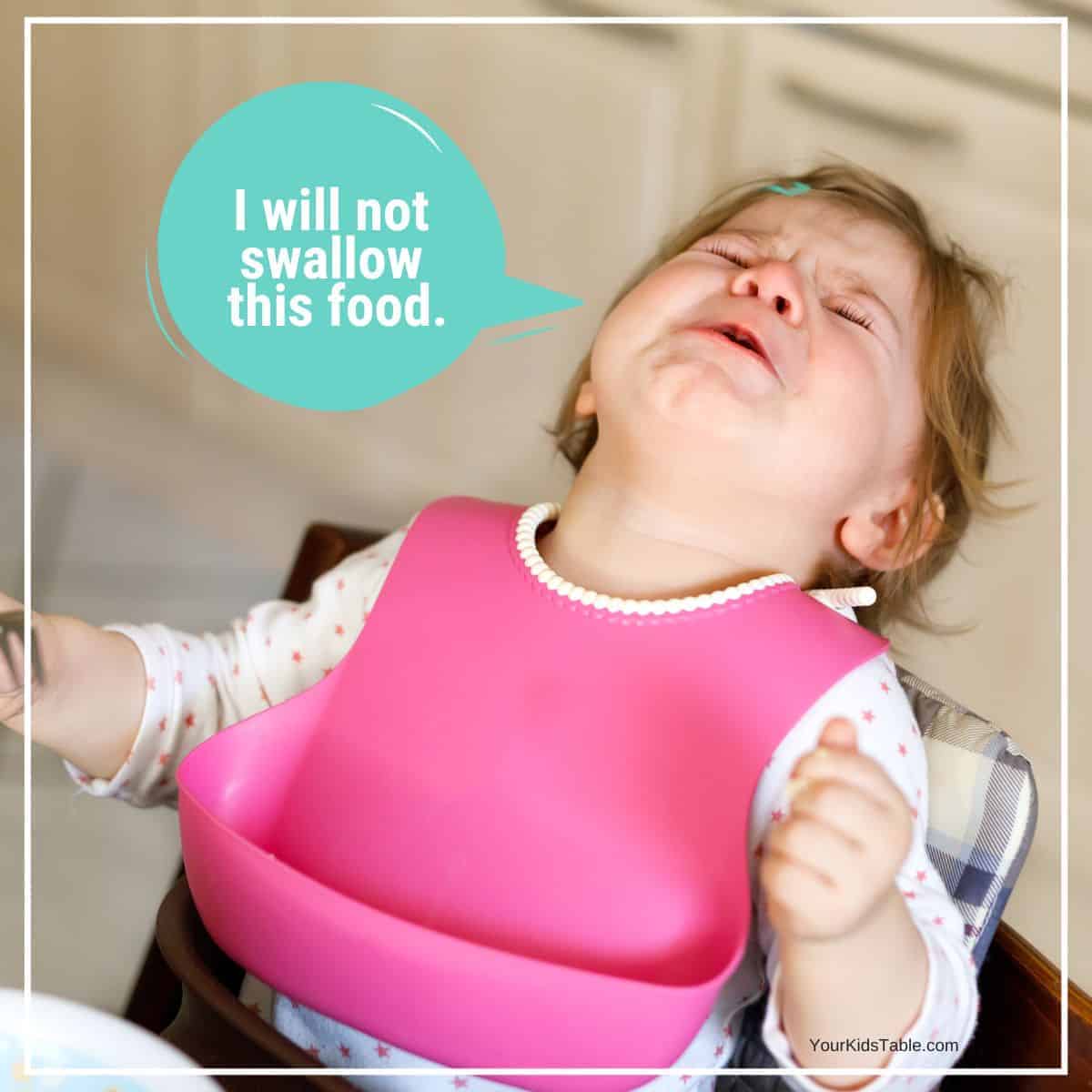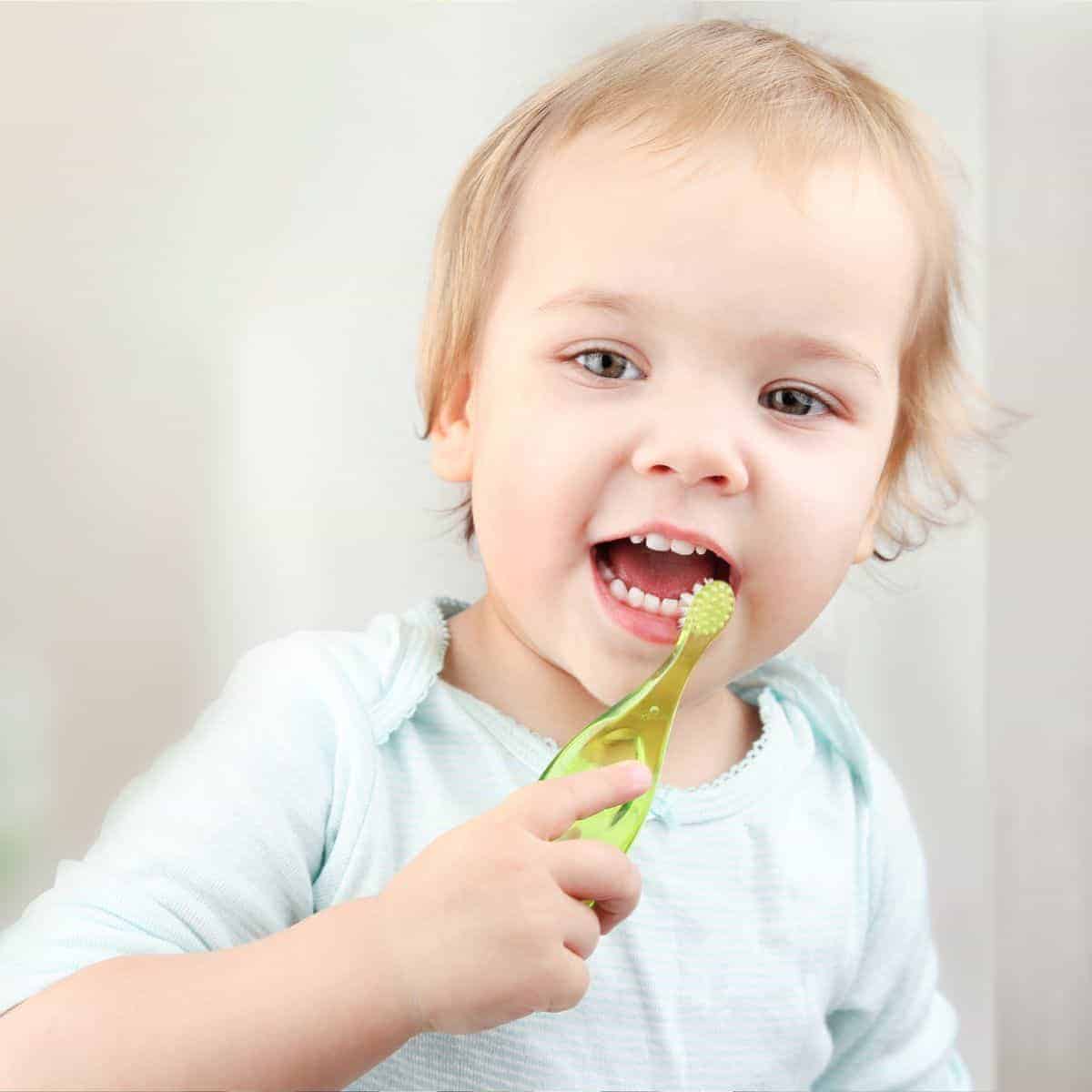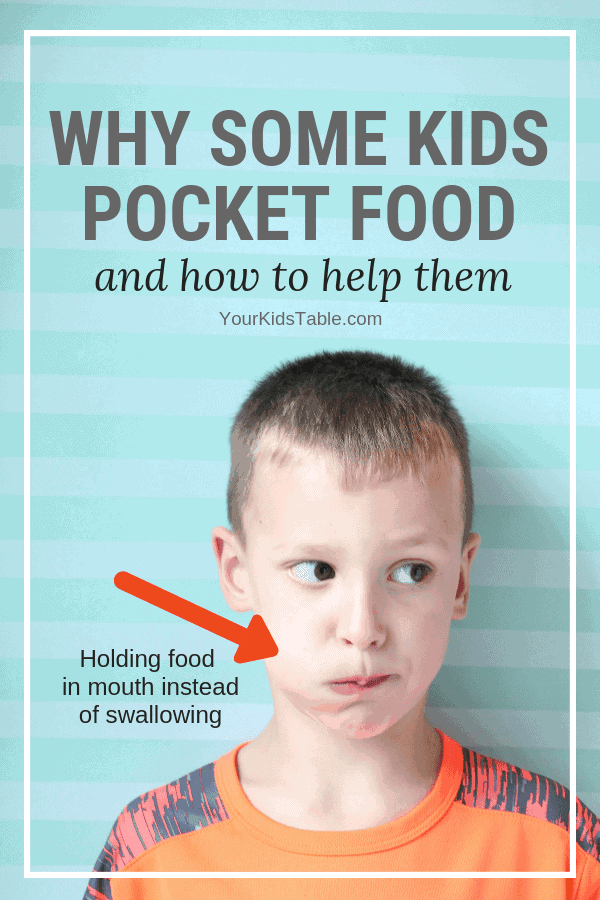Learn exactly what pocketing food is, strategies for how to move past it, and why kids, toddlers, and even babies will pocket their food!
She said, “My daughter does this really weird thing… she doesn’t swallow her food and holds it in her mouth, sometimes for hours.”
My first response was, as strange as it seems, it’s quite common for feeding therapists like myself to see. It’s called pocketing food. Pocketing food can play out in a few different ways, and there are several reasons why kids will stuff, or pocket, their food without any desire to swallow it.
Can it be infuriating for parents? Does it seem bizarre?
Yes.
But, there’s a way to help your child move past pocketing food. Before we get to that though, you have to fully understand what it is and why it happens.
What is Pocketing Food Exactly?
Pocketing food is when a child holds on to food in their mouth without swallowing it. Most kids will hold it in their cheeks or tucked behind or in front of their gums! Either way, it’s as if they’re sticking their food in a little pocket.
Why Do Children, Toddlers, and Even Babies Pocket Food?
Children tend to pocket food in their mouths for a few different reasons, and sometimes, there’s more than one! Let’s take a look at the most common causes for pocketing food in babies, toddlers, and children:
1. Sensory Processing – Children will sometimes get a food in their mouth, realize they don’t like the texture of it, and instead of spitting it out, they just hold on to it.
In other instances, some children can’t feel where the food is very well. It’s something we take for granted as adults, but if a child’s oral sensory sensations aren’t sending the right signals to the brain, it can be as if they can’t find the food. They may not even realize it’s there! At the same time, because they can’t feel the food well in their mouth, they may put way too much in because that increases the sensations, but then the food is too much to handle.
Although any child can face this challenge, mouth stuffing is fairly common in Autism and Sensory Processing Disorder.
Still, some kids pocket food because they like the way it feels. While this may sound stranger yet, it also has to do with what signals the brain is getting. That pocket of food is putting pressure on their tongue, cheek, or gums and it may be soothing. Much the way some people like the way a hat feels on their head or compression gear.
To learn more about the huge impact sensory has on eating and how to help kids overcome it, check out Sensory Issues with Food!
2. Oral Motor Skills – In contrast to sensory issues, oral motor skills have everything to do with the strength and coordination of the muscles inside our mouth. That means, how our tongues move to help with swallowing and chewing, as well as keeping our lips closed to be able to chew without food falling out!
But, that’s just the tip of the iceberg. Head over to Oral Motor Skills to learn more.
Point being, if a child has some weakness with their oral motor skills, the food may get stuck in their mouth and they can’t get the food that’s caught in a pocket of their mouth.

3. Painful or Uncomfortable Swallowing – As a coping mechanism, some kids will hold onto food because it hurts to swallow. This could begin because of a common sore throat, chronic reflux, or swollen tonsils/adenoids, to name just a few reasons.
In some situations, the fear of swallowing becomes a habit, or a learned behavior, and kids need help moving past that mental block.
When kids or toddlers are food pocketing, it’s common to see that they are also extreme picky eaters or having a feeding disorder like PFD. The reasons above cause so much pain or difficulty that it has impacted their ability to eat a variety of foods across the board.
At the same time, if your child only pockets their food occasionally at meal times, it could be because of the food texture. Soft food is easier to lose track of and accidentally stays in their cheek or under their tongue. Some kids may pocket only with new foods because the texture is overwhelming.
If you believe your child is struggling with picky eating, grab our free Picky Eating Essentials printable, it includes 9 important steps to improve eating and 25+ food ideas for picky eaters.
No matter what the case, if your child or toddler is holding food in their mouth with any regularity, it’s important to address it. Let’s talk about how…
Affiliate links used below. See our full disclosure.
How You Can Help Your Child Stop Pocketing Food!
As a parent, there are some simple strategies you can use to help your child swallow the food they’re keeping in their mouth for a long time:
Pocketing Food Strategy #1: Give Small Bites
If you’re feeding a baby or young toddler, only give them a few pieces of food at a time so that it’s easy to manage. For older kids, also try to keep the serving size smaller, and either cut food into smaller pieces or help them to do so. The less food they have to chew and swallow will decrease the chance that it gets pocketed.
Pocketing Food Strategy #2: Take a Drink
A powerful strategy is to teach your child to take a sip of water as soon as they seem to be done chewing or after a few seconds. Depending on their age, you can tell them that taking a drink helps get the food down to their belly. Demonstrate for them, if they don’t understand or follow your directions.
Pocketing Food Strategy #3: Use an Open Cup for Drinks
Using an open cup, if they’re able, helps to flood the mouth with liquid and pull the pocked food down the throat better than a straw or sippy cup. Some kids are able to easily take drinks and maintain their pocketed food, in which case, you’ll need the next tip.
Pocketing Food Strategy #4: Talk Them Through the Steps for Swallowing
Before your child takes a drink, pocket some food in your mouth, in a similar spot to where they’re holding the food. Step by step, tell them how you’re getting the food out of your mouth. That might look a little something like this, tell your child, “Move your tongue over to the food and scoop it out like a shovel. Now, put it on top of your tongue. Take a drink and swallow the food down with your water.”
You may have to demonstrate a few times. It may also be helpful to do this in front of a mirror or bring a hand held one to the table, especially when they can’t feel the food or are working on their oral motor skills.

Pocketing Food Strategy #5: Use a Toothbrush
You can use a toothbrush two different ways to help improve pocketing food. First, is in the moment. If your child or toddler is trying to get the pocketed food out, and can’t, you could use the toothbrush to sweep it out to the front of their mouth where they’ll have more control. From there, your child may be able to swallow or you can couple this with the take a drink trick.
But, a toothbrush, or even better, a vibrating toothbrush like this one, can help a child’s sensory processing and oral motor skills when it’s used 2-3 times a day. Except don’t just brush their teeth, you’ll also want to brush along their gums, tongue, and inside of their cheeks.
However, using a toothbrush for these purposes shouldn’t be forced. If you’re child is sensitive to it, then you’ll want to take it slow and allow them to gradually become more comfortable.
Pocketing Food Strategy #6: Alternate Bites With Something Crunchy
This can be especially helpful for babies and toddlers that are frequently pocketing food, but older kids can be taught to do this if it’s helpful. When sensory is the reason for pocketing food, having very crunchy food consistently gives strong input to the sensory system which can help decrease pocketing.
For example, you may serve your child chicken (a food they tend to pocket) with crunchy apple cubes. After they have a bite of chicken, then their next bite is apples.
Pocketing Food Strategy #7: Don’t Let it Turn into a Battle
Pocketing food can turn into a power that kids will wield when they know it makes their parent go crazy. To avoid that, try to keep your frustrations, although understandable, to yourself. Try to get them involved in overcoming pocketing food and approach it as a team. To learn more about keeping mealtime positive, head to my best picky eating tip.
When You Should Get Help for Pocketing Food
Pocketing food can be a sign that more complex feeding challenges are in play, and feeding therapy may be beneficial for your child. I’d highly recommend keeping your child’s doctor in the loop, and seeking out more help if pocketing food is impacting their ability to eat enough. Feeding therapy is usually done by an occupational therapist, like myself, or a speech therapist.
You can find out how to schedule an appointment for your child in this guide to feeding therapy.
And, if you’d like some more support and next steps for a plan you can start using at home to help your picky eater, grab a free seat in my free 3 Keys to Turn Around Picky Eating Workshop! It’s full or strategies that can start helping today!
Pocketing food can be overwhelming. If you have a tip that has helped your child, share it below in the comments so that we can include even more strategies!
More Help for Feeding Issues in Kids
How to Squash Picky Eating Without Any Nagging
Feeding Red Flags for Babies and Toddlers
A Hidden Cause of Picky Eating: Acid Reflux
Are Food Jags Affecting Your Picky Eater? What you need to know
Alisha Grogan is a licensed occupational therapist and founder of Your Kid’s Table. She has over 18 years experience with expertise in sensory processing and feeding development in babies, toddlers, and children. Alisha also has 3 boys of her own at home. Learn more about her here.
